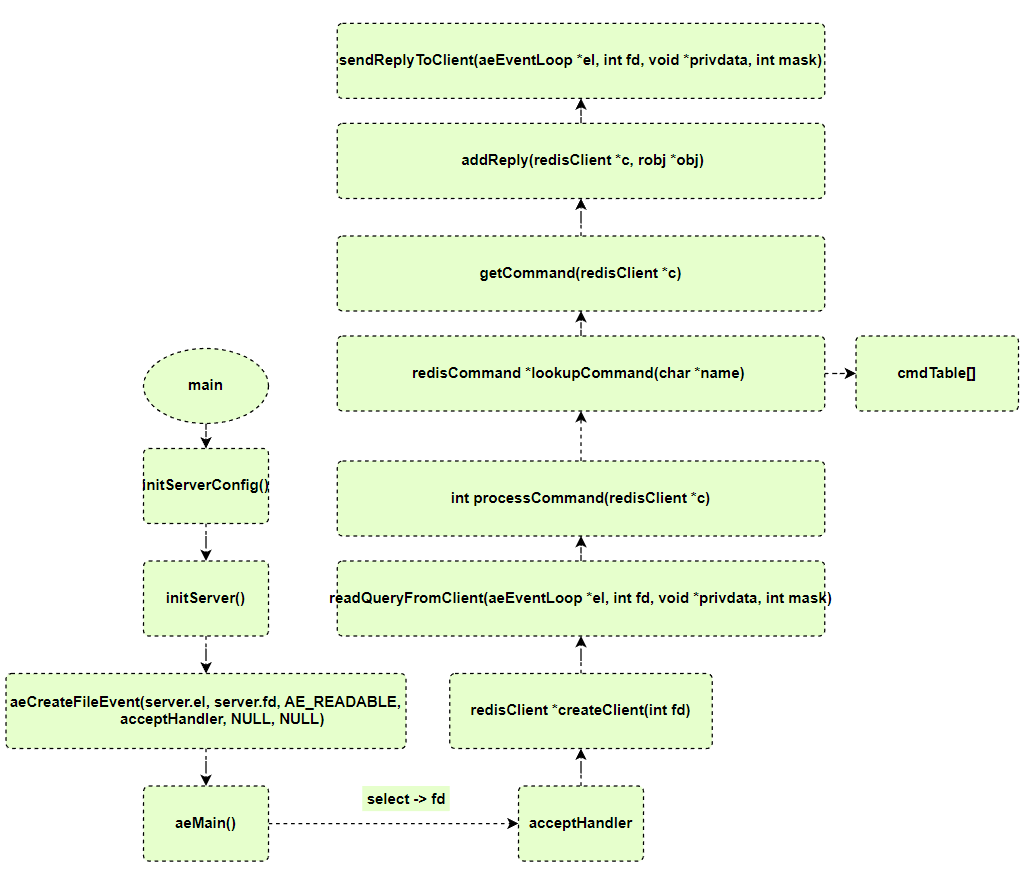[源码阅读]-Redis核心事件流程
Redis核心流程

1.Redis核心流程中的重要数据结构
struct redisServer {
int port;
int fd;
redisDb *db;
aeEventLoop *el;
list *clients;
...
};
typedef struct redisClient {
int fd;
redisDb *db;
sds querybuf;
list *reply;
} redisClient;
typedef struct redisDb {
dict *dict;
dict *expires;
int id;
} redisDb;
typedef struct redisObject {
void *ptr;
int type;
int refcount;
} robj;
typedef struct aeEventLoop {
long long timeEventNextId;
aeFileEvent *fileEventHead;
aeTimeEvent *timeEventHead;
int stop;
} aeEventLoop;
基于以上数据结构,Redis就可以构建核心的Server与client的交互流程
2.Redis核心流程解析
不像一些科学计算的程序,运行一次就可以产出所有结果。Redis功能是通过不断地对外界事件进行响应实现的。这种类型的程序,一般都存在事件循环线程,不断地响应,并处理外界事件。
int main(int argc, char **argv) {
initServerConfig();
...
initServer();
if (server.daemonize) daemonize();
redisLog(REDIS_NOTICE,"Server started, Redis version " REDIS_VERSION);
...
if (aeCreateFileEvent(server.el, server.fd, AE_READABLE,
acceptHandler, NULL, NULL) == AE_ERR) oom("creating file event");
redisLog(REDIS_NOTICE,"The server is now ready to accept connections on port %d", server.port);
aeMain(server.el);
aeDeleteEventLoop(server.el);
return 0;
}
// ...表示略去的不重要的代码
在main函数入口中,主要做了三件事:
- 初始化服务器配置,并初始化服务器
- 使用aeCreateFileEvent函数在服务器结构的事件循环el中注册了事件,事件的回调函数为acceptHandler。这个函数会在server.fd就绪的时候被调用,进行accept行为,建立对应的redisClient资源。(具体细节会在后面进行介绍)
- 开启aeMain()事件循环,处理事件。在redis-1.0的版本中,使用select来对网络I/O行为进行多路复用,当有就绪事件时,就调用事先在事件中注册的回调函数进行处理。
我们来看看acceptHandler函数中的逻辑:
static void acceptHandler(aeEventLoop *el, int fd, void *privdata, int mask) {
...
cfd = anetAccept(server.neterr, fd, cip, &cport);
...
if ((c = createClient(cfd)) == NULL) {
...
}
...
server.stat_numconnections++;
}
acceptHandler函数主要为客户端连接建立了一个redisClient对象,用来管理后续的请求与响应。那么createClient是如何创建redisClient的呢?
下面是createClient函数的源码:
static redisClient *createClient(int fd) {
redisClient *c = zmalloc(sizeof(*c));
anetNonBlock(NULL,fd);
anetTcpNoDelay(NULL,fd);
if (!c) return NULL;
selectDb(c,0);
c->fd = fd;
c->querybuf = sdsempty();
c->argc = 0;
c->argv = NULL;
c->bulklen = -1;
c->sentlen = 0;
c->flags = 0;
c->lastinteraction = time(NULL);
c->authenticated = 0;
c->replstate = REDIS_REPL_NONE;
if ((c->reply = listCreate()) == NULL) oom("listCreate");
listSetFreeMethod(c->reply,decrRefCount);
listSetDupMethod(c->reply,dupClientReplyValue);
if (aeCreateFileEvent(server.el, c->fd, AE_READABLE,
readQueryFromClient, c, NULL) == AE_ERR) {
freeClient(c);
return NULL;
}
if (!listAddNodeTail(server.clients,c)) oom("listAddNodeTail");
return c;
}
在createClient中,首先会设置网络的I/O类型,以及一些TCP参数(说明连接是以TCP的方式进行的)。而后,会选择与客户端相连的数据库,并对redisClient中的一些属性进行初始化。最后会使用redisClient的句柄fd创建一个新的ae可读事件,在这个事件中,使用readQueryFromClient作为回调函数。最后,新建的这个redisClient会被添加到redisServer的clients链表中。
readQueryFromClient做了什么事呢?
static void readQueryFromClient(aeEventLoop *el, int fd, void *privdata, int mask) {
redisClient *c = (redisClient*) privdata;
char buf[REDIS_IOBUF_LEN];
int nread;
REDIS_NOTUSED(el);
REDIS_NOTUSED(mask);
nread = read(fd, buf, REDIS_IOBUF_LEN);
...
again:
if (c->bulklen == -1) {
/* Read the first line of the query */
char *p = strchr(c->querybuf,'\n');
size_t querylen;
if (p) {
...
if (c->argc && processCommand(c) && sdslen(c->querybuf)) goto again;
return;
} else if (sdslen(c->querybuf) >= REDIS_REQUEST_MAX_SIZE) {
redisLog(REDIS_DEBUG, "Client protocol error");
freeClient(c);
return;
}
}
...
}
在readQueryFromClient函数中,会执行来自客户端buffer中的命令。并且,该事件的生命周期与响应的redisClient生命周期是一致的(被freeClient函数所关闭),当遇到错误或客户端请求关闭时,才会注销该事件。其余情况,会在每次调用之后,仍存在于事件循环el中。我们可以看到,真正用来执行命令的是processCommand函数
在processCommand函数中,有以下逻辑:
static int processCommand(redisClient *c) {
struct redisCommand *cmd;
...
cmd = lookupCommand(c->argv[0]->ptr);
...
/* Exec the command */
dirty = server.dirty;
cmd->proc(c);
if (server.dirty-dirty != 0 && listLength(server.slaves))
replicationFeedSlaves(server.slaves,cmd,c->db->id,c->argv,c->argc);
if (listLength(server.monitors))
replicationFeedSlaves(server.monitors,cmd,c->db->id,c->argv,c->argc);
server.stat_numcommands++;
/* Prepare the client for the next command */
if (c->flags & REDIS_CLOSE) {
freeClient(c);
return 0;
}
resetClient(c);
return 1;
}
这一部分包含一个查找命令的逻辑以及执行命令的逻辑。所有的命令都被放在cmdTable[]中。
我们以get命令为例,看看get命令的proc函数getCommand都做了什么事情:
static void getCommand(redisClient *c) {
robj *o = lookupKeyRead(c->db,c->argv[1]);
if (o == NULL) {
addReply(c,shared.nullbulk);
} else {
if (o->type != REDIS_STRING) {
addReply(c,shared.wrongtypeerr);
} else {
addReplySds(c,sdscatprintf(sdsempty(),"$%d\r\n",(int)sdslen(o->ptr)));
addReply(c,o);
addReply(c,shared.crlf);
}
}
}
先从db中查找对应的redisObject,并且通过addReply方法加入到响应中。那么addReply做了什么事情呢?
static void addReply(redisClient *c, robj *obj) {
if (listLength(c->reply) == 0 &&
(c->replstate == REDIS_REPL_NONE ||
c->replstate == REDIS_REPL_ONLINE) &&
aeCreateFileEvent(server.el, c->fd, AE_WRITABLE,
sendReplyToClient, c, NULL) == AE_ERR) return;
if (!listAddNodeTail(c->reply,obj)) oom("listAddNodeTail");
incrRefCount(obj);
}
可以看到,在addReply中生成了一个ae可写事件,并注册了名为sendReplyToClient的回调函数。
sendReplyToClient是redisServer解析query,并响应query结果链路中的最后一环:
static void sendReplyToClient(aeEventLoop *el, int fd, void *privdata, int mask) {
redisClient *c = privdata;
int nwritten = 0, totwritten = 0, objlen;
robj *o;
REDIS_NOTUSED(el);
REDIS_NOTUSED(mask);
if (server.glueoutputbuf && listLength(c->reply) > 1)
glueReplyBuffersIfNeeded(c);
while(listLength(c->reply)) {
...
nwritten = write(fd, ((char*)o->ptr)+c->sentlen, objlen - c->sentlen);
...
}
if (nwritten == -1) {
if (errno == EAGAIN) {
nwritten = 0;
} else {
redisLog(REDIS_DEBUG,
"Error writing to client: %s", strerror(errno));
freeClient(c);
return;
}
}
if (totwritten > 0) c->lastinteraction = time(NULL);
if (listLength(c->reply) == 0) {
c->sentlen = 0;
aeDeleteFileEvent(server.el,c->fd,AE_WRITABLE);
}
}
这个函数负责不停的将redisClient.reply中的响应写到客户端。直到没有reply可写之后,调用aeDeleteFileEvent来删除这个事件。(这个事件的生命周期随着一次调用响应结束而结束)。3
3. 总结
看到这里,大家可以发现,redis的核心ae循环处理流程中,始终只有一个主线程在运行。通过事件驱动的方式,处理相应的事件。同时,使用select多路复用来快速响应I/O事件,达到了很高的效率。
参考
- redis-1.0 SOURCE-CODE
- <Go手写Redis>系列


 浙公网安备 33010602011771号
浙公网安备 33010602011771号